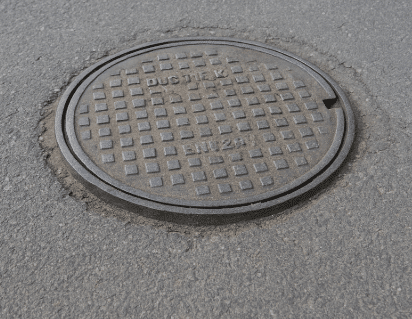The stability and safety of urban road infrastructure depend heavily on the proper installation and long-term performance of manhole covers. However, in many cities around the world, manhole cover settlement problems have become increasingly common, leading to uneven road surfaces, vehicle damage, waterlogging, and potential safety hazards for pedestrians and drivers. Understanding why manhole covers sink and how to prevent or repair this issue is essential for municipal engineers, construction companies, city planners, and infrastructure maintenance teams.
Manhole cover settlement is not a random occurrence—it is the result of structural, environmental, and engineering factors that interact over time. When these factors are not managed properly, even newly installed manhole covers may begin to sink within months. This article provides a comprehensive analysis of the causes of manhole cover subsidence and offers practical engineering solutions to improve performance, extend lifespan, and ensure long-term road safety.
1. Understanding the Manhole Cover Settlement Problem
The manhole cover settlement problem refers to the downward displacement of a manhole cover or its frame relative to the surrounding road surface. This creates unevenness that may worsen over time. The issue is particularly visible in high-traffic urban areas where continuous pressure from vehicles accelerates structural failure.
Several indicators suggest early settlement:
- A noticeable height difference between the manhole frame and road surface
- Increased noise when vehicles pass over the cover
- Cracks appearing around the concrete seating
- Loose manhole frames due to weakened bedding support
- Water accumulation during rainfall
The purpose of studying this issue is not just to repair damage—it is to improve urban road durability and minimize future maintenance costs. Municipal departments often spend millions annually repairing sunken manhole covers, and preventative action is far more cost-effective.
2. Inadequate Road Foundation and Subgrade Weakness
One of the most common causes of manhole cover sinking is poor foundation preparation during construction. When the subgrade under the manhole frame is not compacted to engineering standards, the soil becomes unstable and loses bearing capacity.
Key contributing factors include:
- Insufficient compaction of the soil layer during installation
- Different settlement rates between the manhole structure and the surrounding road
- Soft or water-saturated soil, which compresses over time
- Use of low-strength bedding materials, such as weak mortar or sand
When vehicles pass over the manhole, the applied load transfers unevenly to the soft soil. Over time, the constant pressure causes gradual sinking. As the road surface remains stable, the manhole cover becomes recessed.
Engineering solutions:
- Use high-standard compaction equipment and controlled moisture content
- Replace soft soil with crushed stone or concrete foundation
- Apply graded gravel layers to distribute load
- Conduct geotechnical surveys before project execution
These solutions significantly reduce differential settlement risk.
3. Improper Construction Methods and Low-Quality Materials
Even with a strong foundation, poor construction practices can still lead to settlement. This often occurs when contractors use outdated techniques, rush the project, or lack adequate supervision.
Common construction issues:
- Manhole frame not installed at the same height as the finished road surface
- Uneven concrete pouring around the frame
- Use of low-grade cement or insufficient curing time
- Lack of reinforcement around the manhole chamber
- Failure to follow municipal installation standards
Low-quality materials accelerate wear and reduce structural stability. Weak mortar cracks under stress, allowing water to penetrate and erode the bedding layer, leading to further sinking.
Engineering solutions:
- Use certified, high-strength concrete for frame bedding
- Install steel reinforcement mesh around the frame
- Ensure strict curing procedures (minimum 7 days)
- Apply standard installation tolerance of ±2 mm
Quality control is essential for long-term performance.
4. Traffic Load Stress and Mechanical Fatigue
Manhole covers located on bus lanes, truck routes, or city center roads experience heavy and continuous loads. Over time, repeated mechanical stress leads to micro-movement, frame loosening, and eventually settlement.
Heavy-load factors include:
- Increased number of buses and logistics vehicles in urban areas
- Axle loads exceeding the designed road level
- Continuous vibration transferring stress to the manhole chamber
- Fatigue failure of cast iron components
The higher the traffic volume, the faster the degradation process. Roads designed for light traffic may not support modern urban usage patterns.
Engineering solutions:
- Use heavy-duty manhole covers certified for EN124 D400–F900 load classes
- Install vibration-reducing rubber gaskets
- Apply reinforced concrete rings to support the frame
- Position manholes outside wheel paths whenever possible
These strategies help reduce mechanical stress and extend operational lifespan.
5. Water Erosion, Poor Drainage, and Freeze–Thaw Damage
Water is a major factor behind the manhole cover settlement problem. Poor drainage allows water to infiltrate the structure, weakening the surrounding soil and corroding materials.
Common water-related causes:
- Rainwater infiltration through cracks
- Leakage from underground pipelines
- Freeze–thaw expansion in colder regions
- Soil erosion around the manhole base
- Standing water due to road design errors
When water enters the bedding layer, it washes away supporting material, leaving voids that eventually cause collapse.
Engineering solutions:
- Seal manhole joints with asphalt-based waterproof materials
- Install drainage channels to divert water
- Use anti-corrosion coatings on metal components
- Apply frost-resistant concrete in cold climates
- Routinely inspect underground pipelines
Effective water management is critical for long-term structural stability.
6. Structural Wear, Aging, and Lack of Maintenance
No infrastructure lasts forever—aging is a natural process. Over many years, manhole covers suffer from wear due to environmental exposure, mechanical load, and material fatigue. Without scheduled maintenance, settlement becomes unavoidable.
Signs of aging include:
- Cracked concrete frames
- Rusted manhole covers
- Loosened bolts or locking devices
- Broken edges or displacement
- Progressive lowering of the entire assembly
Preventive solutions:
- Establish annual inspection cycles
- Replace aging concrete seats with polymer or resin concrete
- Use composite materials for their corrosion resistance
- Implement real-time monitoring systems for high-risk areas
A strong maintenance strategy prevents small defects from becoming major failures.
Conclusion
The manhole cover settlement problem is a serious engineering issue affecting road safety, traffic efficiency, and municipal maintenance budgets. Understanding the root causes—from inadequate foundations and improper construction to traffic stress, water erosion, and aging—allows engineers to select appropriate solutions that enhance long-term performance. By combining improved design, strict construction standards, durable materials, and consistent maintenance, cities can significantly reduce settlement incidents and ensure safer, smoother urban road systems.
FAQ (Frequently Asked Questions)
1. What is the main cause of manhole cover settlement?
The primary cause is insufficient foundation compaction, which leads to uneven load distribution and gradual sinking under traffic stress.
2. How can water infiltration cause settlement?
Water erodes soil and weakens concrete, creating voids beneath the manhole frame. Over time, the cover sinks into these voids.
3. What types of manhole covers are best for preventing settlement?
Heavy-duty cast iron or composite covers certified under EN124 D400 or above offer better resistance to traffic load and structural fatigue.
4. How often should manholes be inspected?
Annual inspections are recommended, with more frequent checks on high-traffic or high-risk roads.
5. Can settlement be repaired without replacing the manhole cover?
Yes—engineers can relevel the frame, rebuild the concrete bedding, and reinforce the surrounding structure if damage is not severe.





